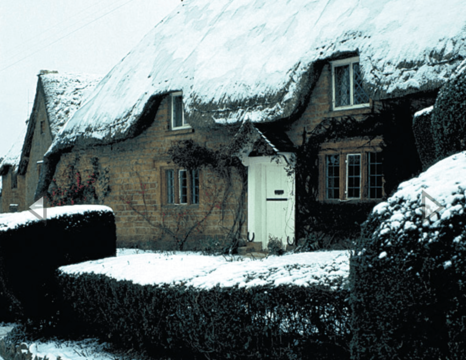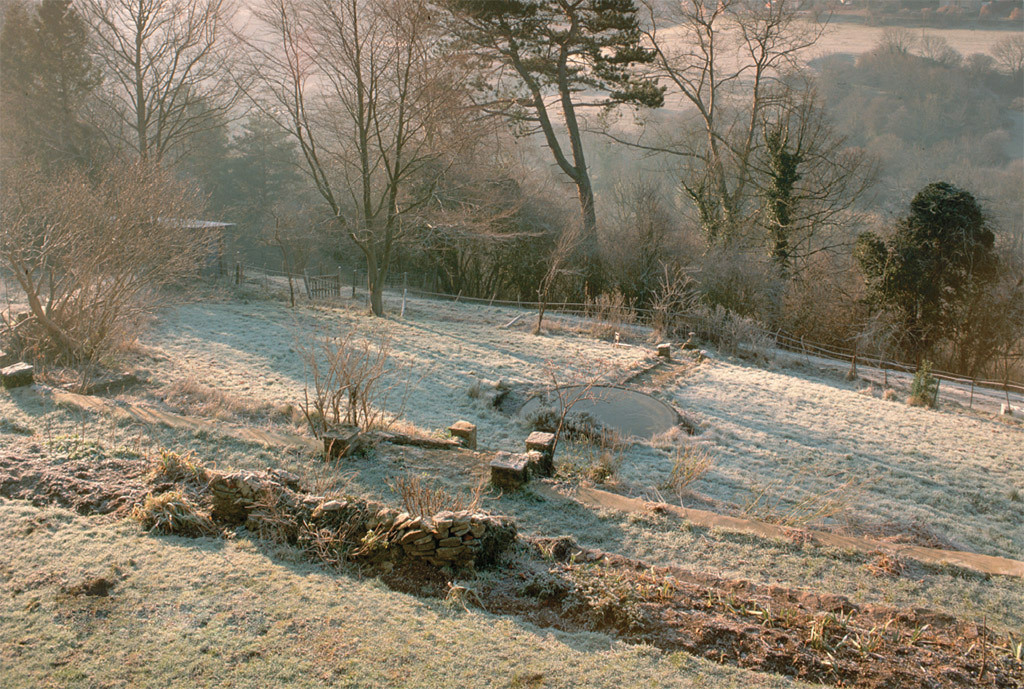
Snow decorates a thatched cottage in Great Tew.[BritainsView.com
Illustrated wonderfully in literature, quaint, and idyllic, we explore the whimsy and history of Christmas in the Cotswolds and Gloucestershire.
I admit, like many people, to a cocooning vision of crusty white snowscapes and baggy-clothed boys bawling “Kingwenslush” along lantern-lit lanes at the mere mention of the Cotswolds at Christmas. Laurie Lee’s deft portrait of the church choir on its annual escapade “carol-barking” in his 1959 classic Cider With Rosie rolls into one the idyll and realism of childhood amid the region’s limestone hills running 50 miles northeast from Bath.
Perhaps, too, I glimpse a flurry of little brown mice from Beatrix Potter’s The Tailor of Gloucester, secretly hurrying to finish sewing the mayor’s waistcoat in time for his wedding “on Christmas Day in the morning.” That author later remarked, “The queerest thing about it is that I heard [the story] in Gloucestershire and that it is true,” though she substituted mice for the fairies to whom the original tailor attributed the nocturnal work.
Read more
Nostalgia and whimsy? Maybe. But more than a snowflake of quintessence prevails in this landscape of golden-stone villages and towns scattered through deep valleys where, even today, folk at Bourton-on-the-Water place their illuminated Christmas tree not on a green or square but, curiously (and atmospherically), in the river; where some people still believe that a ghostly Black Abbot appears each yuletide at Prestbury church; and where everyone knows that the pantomime hero Dick Whittington was indeed a real-life local lad who made good.
To sample more of the Cotswolds and Gloucestershire at Christmas, if you’re not already ensconced with friends and relatives living there, it’s a lip-licking treat to join one of the traditional house parties thrown by various historic luxury hotels.
A little more than a hoarse carol bark or two away from Laurie Lee’s beloved village of Slad, in the Stroud Valleys where his childhood reminiscences are set, Painswick Hotel & Restaurant extends a typical invitation to feasting and entertainment. Think four-posters, antiques, and sink-into sofas beside a roaring log fire in the drawing-room, and you’re there. The hotel is a former rectory, built in 1790 in the Palladian style and reached via Painswick’s winding streets of merchant houses and cottages straight from the medieval heyday of the wool trade.
After a welcoming afternoon tea, guests settle in for a leisurely three days of wining and dining, with time to explore the locale and walk off the likes of butter-roasted turkey and homemade plum pudding. One highlight is to visit nearby 14th-century St. Mary’s Church for Christmas Eve midnight Mass. Take the time to reflect on the shadowy silhouettes of the famous 99 yew trees in the churchyard—according to legend, a 100th one will never grow.

Morning hoarfrost is a more famillar sight than snow across the winter landscapes of the Cotswolds. John Heseltine/CORBIS
Throughout the Cotswolds, grand and quaint “wool” churches, endowed by the merchants who brought wealth to the area in the Middle Ages, are aglow at this time of year. Tewkesbury Abbey, Bath Abbey and Gloucester Cathedral also resound to carol services, the latter just along the narrow lane from the House of the Tailor of Gloucester. The little building that Beatrix Potter depicted to illustrate her magical yarn is now a shop and museum.
Centuries earlier, a far more important book was conceived when William the Conqueror held his Christmas court in Gloucester. Edward the Confessor had established the practice, and the Norman kings followed suit, also indulging in a spot of seasonal hunting in the Forest of Dean. In 1085, at the Chapter House of what is now Gloucester Cathedral, William commissioned the compilation of the Domesday Book, and thus began the most remarkable census ever undertaken, affording a priceless record of medieval England.
Hunting in the area continues to this day, and the spectacle of riders in their red coats—somewhat confusingly termed “hunting pink”—is a Boxing Day tradition. Hotels like Calcot Manor, near the ancient market town of Tetbury to the east of Painswick, offer guests excursions to watch the meet gather, in this case, the renowned Beaufort Hunt.
Cistercian monks built Calcot Manor in the 14th century, and one wonders what they would make of today’s Christmastide of mince pies and scones in front of open fires, dinner to the accompaniment of a string quartet, and luxuriating in the hotel’s spa. No doubt the visit of local choristers on Christmas Eve would strike the right note.
One guesses, too, that Edward Stafford, third Duke of Buckingham, would feel at home again at Thornbury Castle, his former residence southwest of the Cotswolds. Guests here are entertained to a falconry display and Pete the Fool, a “medieval” jester and fire-eater, and after they’ve unwrapped gifts on Christmas morning they can hear about the 500-year-old castle’s eventful history over sherry in the lounge. When Henry VII was on the throne, Buckingham gained high favor after crushing the Perkin Warbeck disturbances. Affluent and influential—he was made constable of England—he lived in some style at Thornbury, as an extract from his household book suggests:
Thornbury. The Feast of the Nativity. Saturday, 25th December, 1507.
Dined 95 gentry, 107 yeomen, 97 garcons.
Supped 84 gentry, 114 yeomen, 92 garcons.
Archates, 4 swans price 12s. 4 geese 2s. 5 suckling pigs 20d. 14 capons 8s. 18 chickens 18d. 21 rabbits 3/6d. 1 peacock 2s. 3 mallards 8d. 5 widgeons 10d. 12 teals 12d. 3 woodcocks 8d. 22 syntes 12d. 12 large birds 3d. 400 hens eggs 3/4d. 20 dishes of butter 20d. 10 flagons of milk 10d. 1 flagon of rum 6d. 2 flagons of Frumety 4d. in herbs 1d.
Kitchen spent on the Lord’s store
1 carcase and seven rounds of beef price 20s.
9 carcases of mutton price 16s.
4 pigs 8s.
1½ calves 4s.
Cellar spent 11 pottles and 3 quarts of Gascony wine price 13s.
1½ pitchers of Rhenish wine price 15d.
½ pitcher Malvoisey price 6d.
Buttery. Spent in aile 171 flagons, 1 quart, price 13s. 7½d.
Despite all that, today’s guests are probably more than content to settle for a “mere” champagne reception in the Old Castle Tudor Kitchen and five-course gourmet dinner on Christmas Eve, followed by a feast with all the trimmings on Christmas Day and port tastings in the evening.
For Buckingham, things ended badly. Beginning in 1511 he had begun to castellate Thornbury, and 10 years later he was accused of treason for “certain words spoken.” He was executed in May 1521, and Henry VIII appropriated his castle. Now, though, such turbulence is long vanished, and the hotel exudes only comfort and opulence in its baronial-style rooms and bed chambers furnished with four-posters, coronet beds and tapestries.
There’s further food for thought at Victorian-origin Three Ways House at Mickleton, in the northern Cotswolds, for this is the home of the eccentric Pudding Club. Alongside afternoon tea and cake, champagne and dinner, midnight Mass and mince pies, there’s the opportunity on Boxing Day to sample the hotel’s renowned desserts at the Pudding Club Table.
The club was founded in 1985 as a lighthearted celebration of Britain’s traditional puddings like jam roly-poly, spotted dick and bread and butter pudding. It became so popular that it now has members worldwide. The hotel holds twice-monthly Pudding Club evenings when diners can sample as many helpings as they like of seven different sumptuous puds. The evening follows its own quirky etiquette and culminates with a vote for the best pudding. A vote for Pudding of the Year occurs at the final club meeting, for 2004 on December 30, as part of the hotel’s New Year holiday festivities.
“Many of our puddings were very popular with the Victorians, who were great pudding people, particularly the Royal Family,” Three Ways House co-owner Jill Coombe says. Apparently, Prince Albert adored plum pudding, and each Christmas 150 small ones were made for the royal household.
If by now you feel that a little exercise is called for, another highlight of staying at Three Ways House is a Boxing Day walk around the hidden parts of nearby Chipping Campden with guide Maureen Sutherland. The market town’s perfectly preserved, curving High Street is one of the finest in the Cotswolds, with plenty of intriguing alleyways running off it to explore. Sutherland also points out subtle details like the “cart wash,” a dip in the road through which folk drove their carts to wash wheels and horses' hooves.
Many of Chipping Campden’s most interesting buildings date from the reign of King James I, when the wool trade was at its zenith and merchants like Sir Baptist Hicks “sought a toehold in heaven by spending vast sums on good works,” Sutherland explains. Hicks built the almshouses and Market Hall, but the town’s crowning glory is its 15th-century church full of treasures and curios, including rare vestments and altar hangings. The brave can climb the 120-foot tower for views across the countryside, and your hosts will meet you at the town’s Old Court House with mulled wine—and a cake with a file in it!
Chipping Campden boasts several ghosts—an environment perfect for tales on cold, dark nights. You might, for example, glimpse a spectral coach and horses said occasionally to drive at midnight from the church along the High Street to the seasonably named Noel Arms. Or if you stay at the Cotswold House Hotel on The Square, you could even meet the friendly apparition of an early 20th-century resident, Mrs. Wallace, on the elegant circular staircase.
During Christmas at the Cotswold House you’re treated to champagne cocktails and candlelit dinners mulled wine after midnight service in one of the town’s churches, as well as a traditional five-course luncheon. Believe it or not, there’s even a pillows and bedding menu, so that you can choose the type you prefer. The stylish main hotel is complemented by romantic cottages, one with its own secret garden.
From Chipping Campden you can easily visit Stratford-upon-Avon, where during the yuletide season you’ll find Beauty and the Beast played out in preserves more often associated with the Bard. For Gloucestershire’s own unique pantomime hero, however, head for the Theatre Royal, Bath, where this year Dick Whittington takes center stage. Guests who stay at the Royal Crescent Hotel in the heart of this World Heritage City can arrange for tickets to be awaiting them on arrival. The real Richard Whittington (circa 1358-1423) was the youngest son of Sir William Whittington of Pauntley in Gloucestershire and grew up to become an immensely rich merchant of London, as well as “thrice lord mayor,” 1397-98, 1406-07 and 1419-20.
The Royal Crescent Hotel occupies the two central buildings in John Wood the Younger’s sublime Royal Crescent, which took him eight years to complete beginning in 1767. Its own spa continues the bathing traditions of the city’s Roman and Georgian heydays, the latter when Beau Nash was the city’s master of ceremonies and Jane Austen cast a perceptive eye on the social mores. At the Royal Crescent Christmas House Party, you will be personally greeted by the concierge and enjoy a champagne and canapé reception with carols by candlelight. There is also a lighthearted treasure hunt, Christmas lunch and the chance to spend Boxing Day at Wincanton races.
Wherever you enjoy Christmas in the Cotswolds and Gloucestershire, you’ll find the same sun-mellowed towns and villages, soft hills and twisting lanes that inspired Laurie Lee. And as carols ring out through the “faint crackling silence of the winter night,” maybe you’ll echo Lee, who wrote, “two thousand Christmases became real to us then.”
* Originally published in July 2016.





Comments